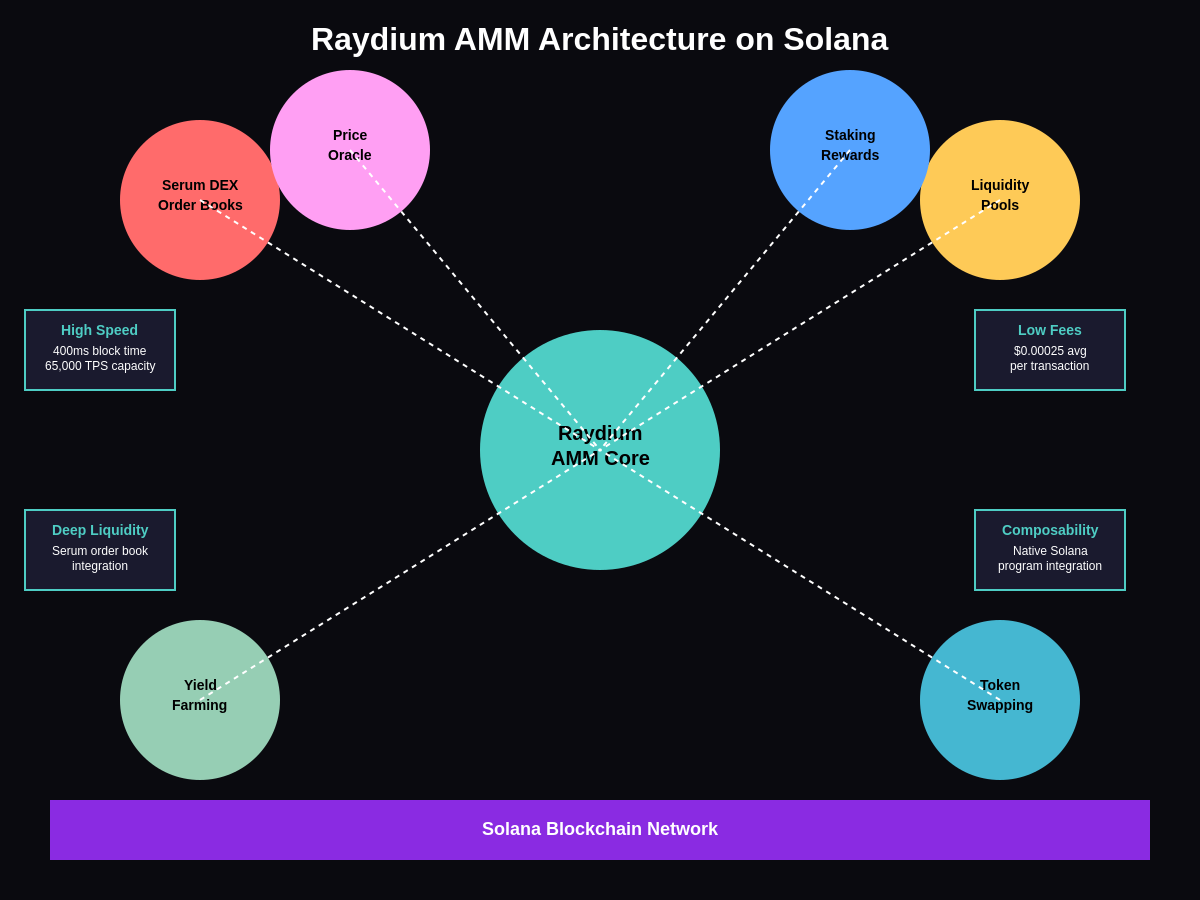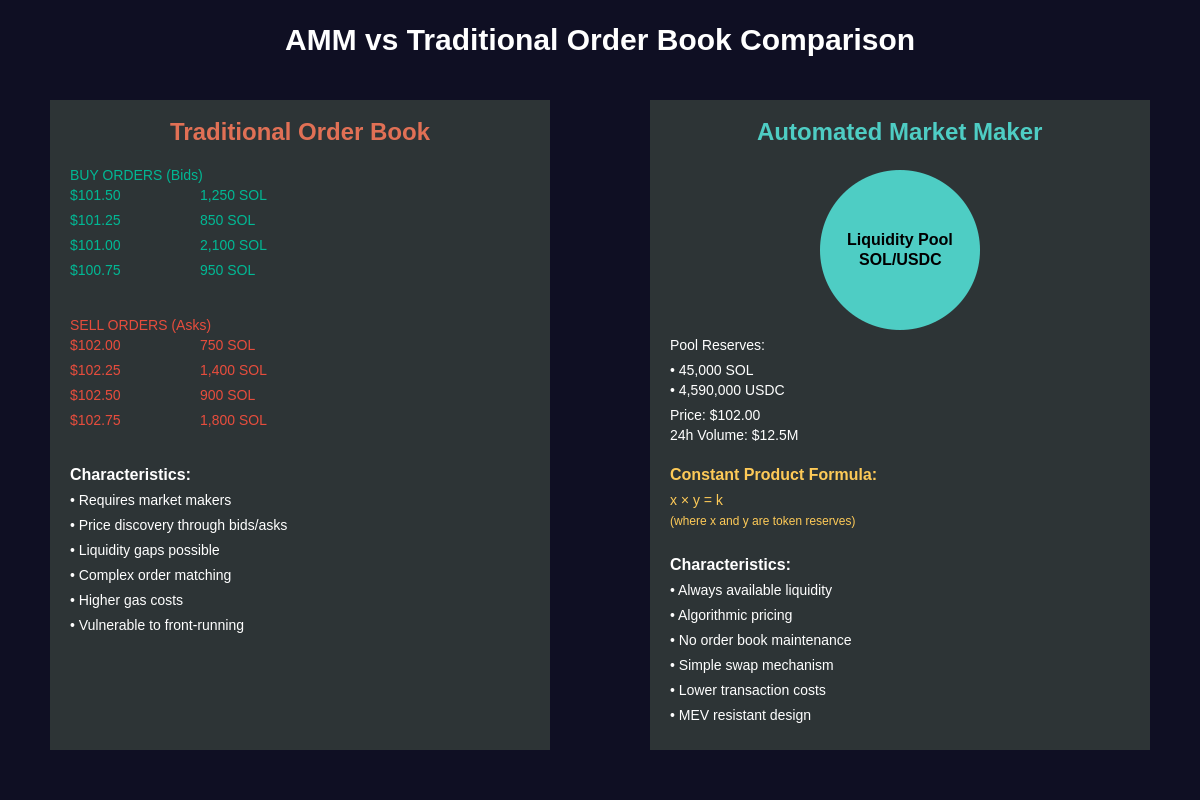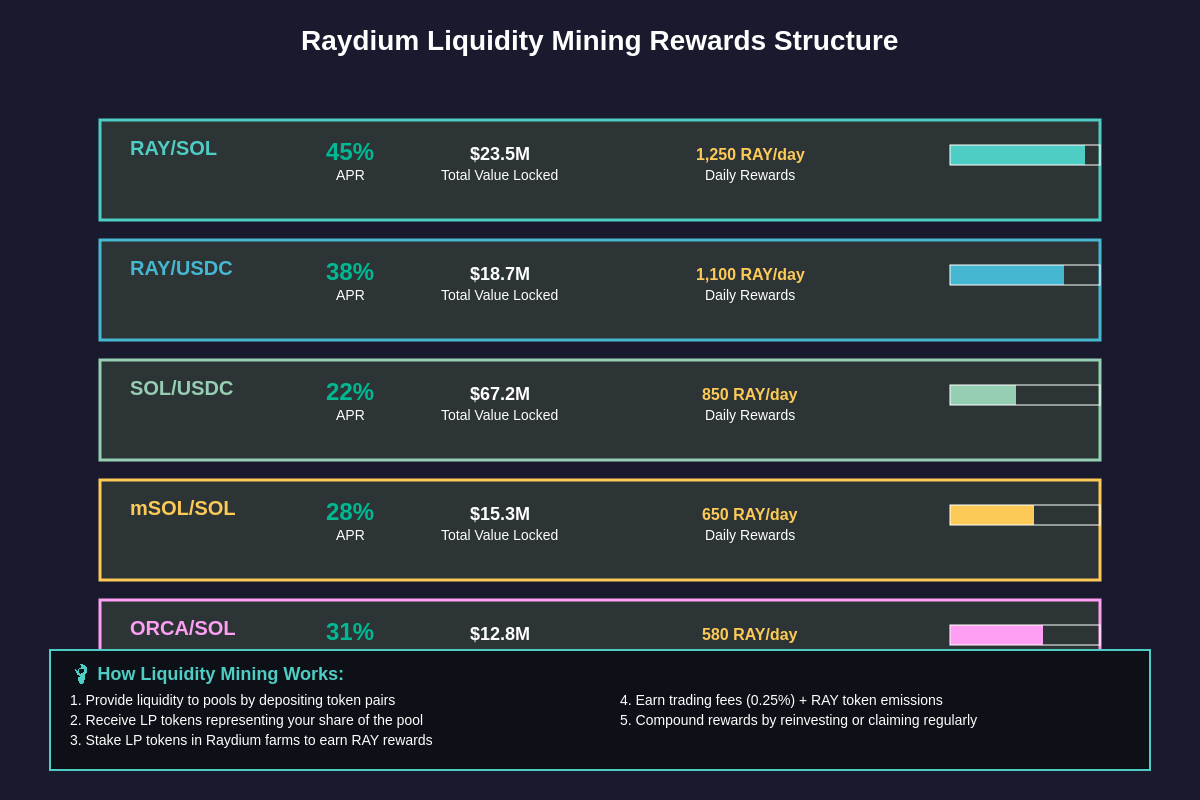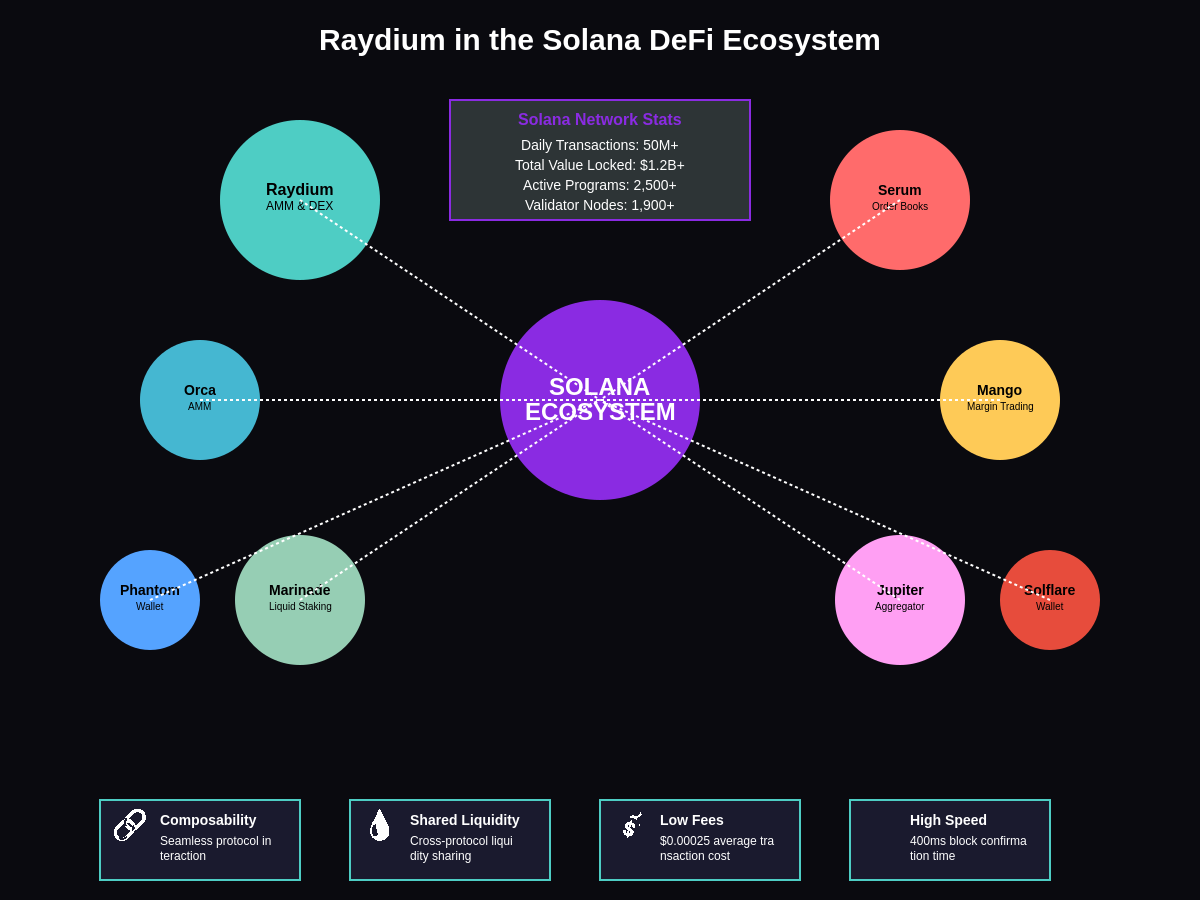The Evolution of Automated Market Making on Solana
Raydium represents a groundbreaking evolution in automated market making technology, built specifically to harness the unique capabilities of the Solana blockchain while addressing the fundamental limitations that have historically plagued decentralized exchanges. As the first automated market maker to provide on-chain liquidity to Serum’s central limit order book, Raydium has established itself as a critical infrastructure component in the rapidly expanding Solana DeFi ecosystem, demonstrating how innovative protocol design can unlock new possibilities for decentralized finance.
The development of Raydium emerged from a recognition that traditional automated market makers, while revolutionary in their own right, faced significant constraints in terms of capital efficiency, price discovery mechanisms, and liquidity utilization that could be overcome through thoughtful integration with established order book systems. Unlike conventional AMMs that operate in isolation with their own liquidity pools, Raydium’s hybrid approach combines the accessibility and simplicity of automated market making with the depth and sophistication of professional trading infrastructure, creating a unique value proposition that serves both retail users and institutional participants.
The protocol’s architecture represents a sophisticated balance between innovation and proven trading mechanisms, leveraging Solana’s high-performance blockchain to enable complex operations that would be prohibitively expensive on other networks. This foundation allows Raydium to offer features and capabilities that extend far beyond simple token swapping, including advanced yield farming opportunities, liquidity mining incentives, and seamless integration with the broader Solana ecosystem that creates compounding benefits for all participants.

Understanding Raydium’s Hybrid AMM Architecture
Raydium’s revolutionary approach to automated market making stems from its unique hybrid architecture that seamlessly integrates traditional AMM functionality with Serum’s central limit order book, creating a system that delivers superior capital efficiency and enhanced liquidity compared to standalone automated market makers. This integration allows Raydium to offer the best of both worlds, providing the simplicity and accessibility that retail users expect from AMMs while simultaneously tapping into the professional-grade liquidity and price discovery mechanisms that institutional traders require.
The technical implementation of this hybrid system involves sophisticated smart contract interactions that enable Raydium’s liquidity pools to serve as both traditional AMM pools for direct swaps and as market makers within Serum’s order book system. When users interact with Raydium, their trades can be executed either through the AMM mechanism or through the order book, depending on which route offers the most favorable pricing at the time of execution. This dynamic routing ensures that users consistently receive optimal execution while maximizing the utility of liquidity across both systems.
The order book integration provides several key advantages over traditional AMM designs, including reduced slippage for large trades, improved price discovery through the continuous interaction between AMM algorithms and active market making, and enhanced capital efficiency through the ability to serve liquidity across multiple venues simultaneously. Professional traders can interact directly with Raydium’s liquidity through Serum’s order book interface, while retail users can continue to use the familiar AMM swap interface, creating a unified liquidity layer that serves diverse user needs without compromising on execution quality.
Price discovery within Raydium’s hybrid system benefits from the constant arbitrage opportunities created by the dual-venue structure, as any price discrepancies between the AMM pools and the order book are quickly exploited by arbitrageurs, leading to more accurate and efficient pricing across both systems. This mechanism ensures that Raydium’s pricing remains closely aligned with broader market conditions while providing additional trading opportunities for sophisticated participants who can capture value from these arbitrage activities.

Solana’s Performance Advantages for DeFi Applications
The selection of Solana as the foundation for Raydium’s automated market maker represents a strategic decision that unlocks capabilities simply not possible on other blockchain networks, particularly in terms of transaction throughput, cost efficiency, and user experience quality that directly translate into superior performance for DeFI applications. Solana’s unique architecture, featuring a hybrid consensus mechanism combining Proof of Stake with Proof of History, enables the network to process over 65,000 transactions per second with average confirmation times of just 400 milliseconds, creating an environment where complex DeFi operations can execute with near-instantaneous finality.
The cost advantages of building on Solana become particularly apparent when comparing transaction fees across different blockchain networks, with Solana trading data showing average transaction costs of approximately $0.00025 compared to Ethereum’s frequently fluctuating fees that can range from tens to hundreds of dollars during periods of network congestion. This dramatic difference in transaction costs enables new DeFi use cases that would be economically unfeasible on higher-cost networks, such as frequent rebalancing of yield farming positions, small-value trades, and complex multi-step strategies that require multiple on-chain transactions.
The technical architecture of Solana also provides significant advantages for automated market maker operations through its support for parallel transaction processing and sophisticated state management that allows multiple operations to occur simultaneously without network bottlenecks. This capability is particularly valuable for AMM protocols that need to handle high volumes of concurrent swaps, liquidity additions and removals, and yield farm interactions without degrading performance or creating competition for block space that drives up transaction costs.
Solana’s account model and program architecture enable Raydium to implement sophisticated features that would be challenging or impossible to deploy efficiently on other networks, including complex yield farming mechanisms, automated compounding strategies, and seamless cross-protocol integrations that enhance the overall user experience. The network’s native support for cross-program invocations allows Raydium to interact directly with other Solana protocols within single transactions, enabling composite operations that reduce user friction and gas costs while expanding the scope of possible DeFi strategies.
Liquidity Mining and Yield Farming Mechanisms
Raydium’s approach to liquidity mining and yield farming represents a sophisticated evolution of traditional reward mechanisms, designed to create sustainable incentives for liquidity provision while building a robust ecosystem of engaged participants who contribute to the protocol’s long-term growth and stability. The protocol implements a multi-layered reward structure that combines trading fee earnings, token emissions, and additional yield opportunities through partnerships and integrations, creating compelling returns for liquidity providers across different risk profiles and investment timeframes.
The core liquidity mining mechanism operates through a series of carefully calibrated farms that offer RAY token rewards to users who provide liquidity to designated trading pairs and stake their resulting LP tokens in the farming contracts. These rewards are distributed proportionally based on the amount and duration of liquidity provided, with additional multipliers and bonuses available for longer-term commitments and participation in governance activities. The emission schedule is designed to balance attractive short-term returns with long-term token distribution goals, ensuring that early participants are rewarded while maintaining sufficient incentives for future growth.
Raydium’s yield farming opportunities extend beyond simple liquidity provision through integration with other Solana protocols and the creation of complex yield strategies that maximize returns through automated compounding and cross-protocol interactions. Users can participate in multi-token farms that offer rewards in multiple currencies, take advantage of boosted yields through governance token staking, and access exclusive farming opportunities through partnerships with other DeFi protocols, creating a comprehensive yield generation ecosystem that caters to different investment approaches and risk tolerances.
The protocol’s approach to sustainable tokenomics includes careful management of emission rates, regular assessment of farm performance and participation levels, and ongoing adjustments to ensure that rewards remain attractive while preventing excessive inflation that could undermine token value. RAY price movements reflect the market’s assessment of these tokenomics decisions and the overall health of the ecosystem, with successful farming programs generally correlating with increased token demand and ecosystem growth.

Cross-Protocol Integration and Composability
The true power of Raydium within the Solana ecosystem emerges through its extensive integration capabilities and composability features that enable seamless interaction with other protocols, creating a interconnected DeFi landscape where value and functionality compound across different applications. Raydium serves as a critical liquidity layer for numerous other Solana protocols, providing the foundational infrastructure that enables everything from lending platforms to synthetic asset protocols to function efficiently while accessing deep, reliable liquidity for their operations.
Integration with major Solana wallets including Phantom, Solflare, and others ensures that users can interact with Raydium through familiar interfaces while benefiting from advanced features like transaction simulation, slippage protection, and optimal routing that enhance the overall user experience. These wallet integrations also enable Raydium to be easily incorporated into mobile DeFi experiences and hardware wallet workflows, expanding accessibility and reducing barriers to participation for users across different technical skill levels and security preferences.
The protocol’s composability extends to integration with yield aggregators, portfolio management tools, and automated strategy platforms that can programmatically interact with Raydium’s smart contracts to execute complex multi-step operations on behalf of users. This ecosystem of building tools and services creates network effects that increase the utility and adoption of Raydium while providing additional value streams and use cases that benefit all ecosystem participants.
Raydium’s role as liquidity infrastructure for other protocols creates valuable partnerships and integration opportunities that drive mutual growth and innovation within the Solana ecosystem. Lending protocols rely on Raydium for liquidation mechanisms and asset pricing, synthetic asset platforms use Raydium pools for rebalancing and arbitrage activities, and derivative protocols leverage Raydium’s liquidity for underlying asset exposure, creating a web of interdependencies that strengthen the entire ecosystem while providing multiple revenue and growth vectors for the protocol.

Advanced Trading Features and User Experience
Raydium’s user interface and trading features represent a careful balance between accessibility for newcomer users and sophistication for professional traders, implementing advanced functionality that enhances trading efficiency while maintaining the intuitive design principles that make automated market makers approachable for retail participants. The platform offers multiple trading interfaces, including a streamlined swap interface for simple token exchanges, an advanced trading view with detailed market data and analysis tools, and API access for programmatic trading and integration with external applications and trading bots.
The protocol implements sophisticated routing algorithms that automatically determine the optimal execution path for each trade, considering factors such as slippage, price impact, trading fees, and available liquidity across both AMM pools and the integrated Serum order book. This intelligent routing ensures that users receive the best possible execution without needing to understand the complex technical details of how their trades are processed, while advanced users can access detailed execution information and customize their trading parameters to suit specific requirements.
Slippage protection and maximum exchange rate features provide users with control over their trading outcomes while protecting against adverse price movements during transaction execution, particularly important given the volatile nature of cryptocurrency markets and the potential for rapid price changes between transaction submission and confirmation. These features include customizable slippage tolerances, price impact warnings for large trades, and automatic transaction cancellation if market conditions change unfavorably during the execution process.
The user experience extends beyond basic trading functionality to include comprehensive portfolio tracking, yield farming management tools, and detailed analytics that help users optimize their DeFi strategies and monitor their performance across different activities within the Raydium ecosystem. Integration with popular portfolio tracking services and the availability of detailed transaction history and performance metrics enable users to maintain clear visibility into their DeFi activities and make informed decisions about future strategies and capital allocation.
Risk Management and Security Considerations
Security represents a paramount concern for any DeFi protocol handling significant amounts of user funds, and Raydium has implemented comprehensive security measures and risk management practices designed to protect user assets while maintaining the decentralized nature of the protocol. The protocol undergoes regular security audits by reputable blockchain security firms, maintains bug bounty programs that incentivize responsible disclosure of potential vulnerabilities, and implements multi-signature governance mechanisms that prevent single points of failure in protocol administration.
Smart contract risk mitigation includes the use of battle-tested code patterns, extensive testing procedures, and gradual rollout processes for new features that allow potential issues to be identified and addressed before they can impact large amounts of user funds. The protocol’s integration with Serum also benefits from the security measures and audit history of that established platform, creating multiple layers of security review and validation for the underlying trading infrastructure.
Liquidity provider risks include impermanent loss exposure, smart contract risks, and token-specific risks that users should carefully consider before providing liquidity to different pools, with the protocol providing educational resources and risk assessment tools to help users make informed decisions about their participation. The protocol implements various mechanisms to help mitigate these risks, including impermanent loss protection programs, diversified reward structures that help offset potential losses, and clear communication about the risks associated with different activities.
Governance risks and centralization concerns are addressed through the progressive decentralization of protocol control, with increasing community participation in governance decisions and the gradual transition of administrative functions to decentralized mechanisms. The RAY token serves as the governance token for the protocol, enabling holders to participate in important decisions about protocol parameters, upgrade proposals, and treasury management, while multi-signature requirements and time delays prevent rapid changes that could adversely impact users.
Economic Impact and Market Performance
Raydium’s economic impact within the Solana ecosystem extends far beyond its direct trading volume and fee generation, encompassing its role as critical infrastructure that enables the broader development and success of the entire Solana DeFi landscape. The protocol’s liquidity provision serves as the foundation for price discovery, arbitrage activities, and efficient capital allocation across numerous other protocols and applications, creating value that multiplies throughout the ecosystem and contributes to the overall growth and maturation of decentralized finance on Solana.
The protocol’s fee structure and tokenomics create multiple value accrual mechanisms for different stakeholders, including trading fees for liquidity providers, protocol fees that support ongoing development and operations, and token appreciation potential for RAY holders who participate in governance and ecosystem growth activities. These aligned incentives help ensure that the protocol’s success translates into benefits for all participants while maintaining sustainable economics that support long-term growth and development.
Market performance metrics including total value locked, trading volume, and active user counts provide insights into the protocol’s adoption and growth trajectory, while comparison with other AMM protocols on different blockchain networks highlights the advantages of building on Solana’s high-performance infrastructure. DeFi analytics platforms track these metrics and provide valuable data for assessing the protocol’s competitive position and growth potential within the broader DeFi market.
The network effects created by Raydium’s success contribute to increased adoption of Solana as a platform for DeFi development, attracting new projects, users, and capital to the ecosystem while strengthening the overall value proposition of building and participating in Solana-based DeFi activities. This virtuous cycle of growth and adoption benefits all ecosystem participants while positioning Raydium as a critical component of Solana’s long-term success in the competitive blockchain landscape.
Future Development and Roadmap
Raydium’s development roadmap reflects an ambitious vision for expanding the protocol’s capabilities and reach while maintaining its core focus on providing superior automated market making services within the Solana ecosystem. Planned developments include the implementation of concentrated liquidity features similar to those introduced by Uniswap V3, which will enable more efficient capital utilization and potentially higher returns for liquidity providers who actively manage their positions within specific price ranges.
Cross-chain expansion represents another significant development focus, with plans to extend Raydium’s liquidity and trading capabilities to other blockchain networks through bridge technologies and multi-chain protocols that will enable users to access Raydium’s services regardless of which blockchain network they prefer to use. This expansion will significantly increase the addressable market for the protocol while maintaining Solana as the primary operational hub that benefits from the performance and cost advantages of the network.
Advanced derivative products and synthetic asset support are planned additions that will transform Raydium from a simple automated market maker into a comprehensive DeFi trading platform capable of supporting complex financial instruments and strategies. These developments will enable new use cases including perpetual futures trading, options markets, and synthetic exposure to traditional financial assets, significantly expanding the protocol’s utility and potential user base.
Governance evolution and progressive decentralization remain ongoing priorities, with plans to further distribute control of the protocol to the community while implementing more sophisticated governance mechanisms that can handle the increased complexity of the expanding protocol suite. These developments will include enhanced voting mechanisms, delegation systems, and specialized governance tracks for different types of protocol decisions, ensuring that the growing Raydium ecosystem can be effectively managed by its stakeholder community.
Continue exploring DeFi opportunities
Conclusion
Raydium’s emergence as a leading automated market maker on Solana represents more than just another DeFi protocol launch; it demonstrates the transformative potential of thoughtful protocol design combined with high-performance blockchain infrastructure to create genuinely superior financial products and services. The protocol’s hybrid approach to automated market making, seamlessly integrating AMM functionality with established order book systems, has established new standards for capital efficiency, user experience, and ecosystem integration that influence development across the entire DeFi landscape.
The success of Raydium validates Solana’s positioning as a premier blockchain for DeFi applications, showcasing how the network’s unique technical capabilities enable innovative solutions that would be impractical or impossible on other platforms. The protocol’s ability to offer professional-grade trading functionality with minimal fees and near-instantaneous execution demonstrates the importance of underlying blockchain performance in determining the quality and accessibility of decentralized financial services.
Looking forward, Raydium’s continued development and expansion will likely play a crucial role in the broader adoption of decentralized finance, both within the Solana ecosystem and across the cryptocurrency industry more generally. The protocol’s commitment to innovation, security, and user experience positions it well to capture the significant opportunities that exist as traditional finance increasingly recognizes the value and potential of decentralized alternatives.
Disclaimer: This article is for informational purposes only and does not constitute financial advice. Cryptocurrency investments involve significant risk, including the potential loss of principal. DeFi protocols are experimental technology that may contain bugs or vulnerabilities. Always conduct your own research and consider your risk tolerance before participating in any cryptocurrency or DeFi activities. Past performance does not guarantee future results.